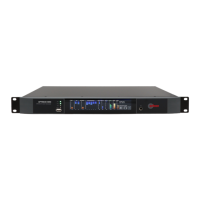5-2 Troubleshooting
Even if the transmission system is operating properly, the FM modulation monitor or reference receiver can falsely
indicate peak program modulation higher than that actually being transmitted if the monitor overshoots at high
and low frequencies. Many commercial monitors have this problem, but most of these problem units can be
modified to indicate peak levels accurately.
Orban uses the Belar “Wizard” series of DSP-based monitors internally for testing, because these units do not have
this difficulty.
Unexpected Delay Between the Program Feed and the On-Air Signal
The diversity delay may have been accidentally applied to the output you are using to drive your transmitter.
Audible Distortion On-Air
Make sure that the problem can be observed on more than one receiver and at several locations. Multipath
distortion at the monitoring site can be mistaken for real distortion (and will also cause falsely high modulation
readings).
Verify that the source material at the 5950's audio inputs is clean. Heavy processing can exaggerate even slightly
distorted material, pushing it over the edge into unacceptability.
The subjective adjustments available to the user have enough range to cause audible distortion at their extreme
settings. There are many controls that can cause distortion, including MULTIBAND CLIPPING, FINAL CLIP DRIVE, and
COMPOSITE CLIP DRIVE. Setting the LESS-MORE control beyond “9” will cause audible distortion of some program
material with all but the Classical and Protect presets. Further, the “Loud” family of presets can sometimes cause
audible distortion with certain program material; this is the price to be paid for “competitive” loudness as it is
defined in certain markets.
If you are using analog inputs, the peak input level must not exceed +27 dBu or the 5950's A/D converter will clip
and distort.
Unlike earlier digital OPTIMODs, there is no input peak level adjustment for the A/D converter. Instead, we have
provided adequate headroom for virtually any facility. This is possible because the A/D converter in the 5950 has
higher dynamic range than older designs. Therefore, without compromising the 5950’s noise level, we could
eliminate a control that was frequently misadjusted.
If you are using the 5950’s stereo enhancer (which most “pop music”-oriented presets do), then this can
exaggerate multipath distortion in high multipath environments. You may want to reduce the setting of the stereo
enhancer’s RATIO LIMIT control. A similar problem can occur if you are using sum-and-difference processing in the
5950’s AGC. In this case, reduce the setting of the AGC’s MAXDELTAGR controls.
If you are using an external processor ahead of the 5950, be sure it is not clipping or otherwise causing problems.
Audible Noise on Air
Excessive compression will always exaggerate noise in the source material.

